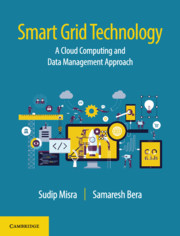Book contents
- Frontmatter
- dedication
- Contents
- Figures
- Tables
- Foreword
- Preface
- Part I Introduction
- Part II Cloud Computing Applications for Smart Grid
- Part III Smart Grid Data Management and Applications
- 11 Smart Meter Data Management
- 12 PHEVs: Internet of Vehicles
- 13 Smart Buildings
- Part IV Smart Grid Design and Deployment
- Index
13 - Smart Buildings
from Part III - Smart Grid Data Management and Applications
Published online by Cambridge University Press: 20 October 2018
- Frontmatter
- dedication
- Contents
- Figures
- Tables
- Foreword
- Preface
- Part I Introduction
- Part II Cloud Computing Applications for Smart Grid
- Part III Smart Grid Data Management and Applications
- 11 Smart Meter Data Management
- 12 PHEVs: Internet of Vehicles
- 13 Smart Buildings
- Part IV Smart Grid Design and Deployment
- Index
Summary
Buildings are one of the most prominent energy consumers in modern-day power grids. In particular, commercial buildings consume large amounts of energy for operating lighting systems, heating–ventilation and air-conditioning (HVAC), and IT equipment including servers. High energy consumption at the buildings increases energy consumption cost and environment pollution. To deal with these issues, buildings can be converted to ‘smart buildings’. Through the concept of smart buildings, electric loads can be controlled in an adaptive manner. Unused equipment can be switched off so that the total energy consumption in the building can be reduced. The appliances that are installed inside a building will generate huge data in order to have real-time information inside the building. To fulfill these objectives, different methodologies exist. In this chapter, we focus on commercial buildings as smart buildings for efficient energy management.
Concept of Smart Building
Most commercial buildings are equipped with HVAC systems, IT equipment, servers, and plug-in equipment. These equipments can be integrated with different sensing and actuation technologies, so that they can be controlled dynamically depending on their requirements. Different useful techniques that are deployed in different buildings to make them smart buildings, are discussed here.
• Sensing: It is the key technology required for setting up a smart building. Different sensors are installed in the building (inside and outside), so that different parameters (such as temperature, smoke, humidity, and motion) can be sensed in real-time. The sensed data are forwarded to the data center network for processing, computing, and decision making. For data collection and forwarding, wireless sensor network (WSN) is an emerging technology that can be used due to its unique features such as the capability of operating in low power. Typically, IEEE 802.15.4-based technologies (such as Zig-Bee and 6LowPAN) are used in WSN to forward real-time data. User context, environment, and energy consumption are three major factors to be monitored to establish a smart building. The sensors that are installed to monitor these components generate huge amount of data. This also requires suitable data management techniques for real-time energy management inside the building, as discussed in Chapter 11.
• Actuation: After sensing the users’ contexts, environment, and energy consumption, actuation is another important task to be employed. HVACs should be controlled in an efficient manner considering the sensed information received from individual sensors.
- Type
- Chapter
- Information
- Smart Grid TechnologyA Cloud Computing and Data Management Approach, pp. 207 - 224Publisher: Cambridge University PressPrint publication year: 2018



